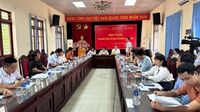On May 7, 2025, Bắc Ninh province completed a significant initiative to rearrange its commune-level administrative units, a move aimed at creating new development opportunities while streamlining governance. This restructuring is part of a broader strategy outlined by the central government to enhance the efficiency and effectiveness of local administration across Vietnam.
In April 2025, Bắc Ninh focused on finalizing a project designed to reorganize its commune-level administrative units. The goal was ambitious: to reduce the total number of these units by approximately 60-70%. This effort reflects the province's commitment to improving local governance in line with national directives.
The newly established Tam Sơn ward is a prime example of this initiative, formed by merging the existing Tương Giang and Tam Sơn wards. The administrative headquarters for the new ward will be located at the current Tam Sơn ward office.
By April 20, 2025, Bắc Ninh had conducted a province-wide consultation, gathering opinions from voters regarding the proposed changes. Remarkably, 96.35% of household representatives expressed their support, indicating a strong consensus among the populace.
Following the restructuring, Bắc Ninh now has a total of 41 new administrative units, comprising 20 wards and 21 communes. This marks a reduction of 80 units, or 66.11%, from the previous structure. The breakdown of the new units includes five wards in Bắc Ninh city, four wards in Từ Sơn city, six wards in Thuận Thành town, five wards and two communes in Quế Võ town, and five communes each in Yên Phong, Tiên Du, Gia Bình, and Lương Tài districts.
In terms of meeting administrative criteria, all 20 newly established wards fulfill the necessary requirements for both area and population. Additionally, nine out of the 21 communes also meet these criteria. However, 12 communes qualify based on population but not area, with seven of these merging three existing units and five merging two.
To ensure the success of this initiative, the province is actively promoting public awareness and support for the restructuring process. This includes mobilizing community engagement and ensuring that all stakeholders, including officials and citizens, are aligned with the goals of the reorganization.
As the province moves forward, it is essential to maintain stability and security throughout the transition. Authorities are committed to closely monitoring the situation in affected areas, ensuring that the changes do not disrupt local governance or community relations.
In tandem with the restructuring in Bắc Ninh, discussions are also underway in Hải Dương province regarding amendments to the regulations governing the number of deputy chairpersons in the Provincial People's Council following administrative mergers. On the same day, delegates at the National Assembly session voiced concerns about the potential for inconsistencies in governance structures as localities consolidate.
Delegate Lê Văn Hiệu raised a critical point about the inadequacies in the current regulations, highlighting that the draft law stipulates only one deputy chairperson if the chairperson is a full-time delegate, and two if they are part-time. He emphasized that many localities could end up with two to four deputy chairpersons due to the ongoing administrative consolidations.
To mitigate these potential conflicts, Delegate Lê Văn Hiệu proposed an amendment to the draft law, urging the National Assembly Standing Committee to specify the number of deputy chairpersons allowed in the Provincial People's Council. This recommendation reflects the need for clarity and coherence in governance as administrative structures evolve.
Delegate Triệu Thế Hùng echoed this sentiment, advocating for clearer regulations regarding the responsibilities of the Provincial People's Committee and its chairpersons at all levels, thereby enhancing decentralization. Meanwhile, Delegate Bùi Sỹ Hoàn called for clarification on whether the Provincial People's Council has the authority to decentralize, ensuring consistency with other laws.
The discussions around the draft law also touched on the importance of attracting talented individuals into public service. Delegate Triệu Thế Hùng emphasized the need for specific provisions that link salary and benefits to job positions, particularly to draw talent from the private sector. He underscored the necessity for clear criteria to evaluate talent in public service, suggesting that a more transparent and quantifiable approach would enhance objectivity in assessments.
Furthermore, Delegate Đinh Thị Ngọc Dung proposed mandatory evaluations based on citizen satisfaction with civil servants handling administrative procedures. She highlighted the effectiveness of electronic surveys in assessing public service quality, suggesting that such measures should be implemented to ensure accountability and improvement in service delivery.
As these discussions unfold, the overarching theme remains focused on creating a streamlined, effective, and responsive local government that prioritizes the needs of the people. The ongoing administrative restructuring in Bắc Ninh and the legislative discussions in Hải Dương reflect a nationwide commitment to enhancing governance and public service delivery.
The process of restructuring administrative units is not merely about reducing numbers; it is fundamentally about building a more effective government that is closer to the citizens it serves. With the support of the local population and a clear vision for the future, provinces like Bắc Ninh and Hải Dương are poised to make significant strides in improving their administrative frameworks and enhancing the quality of governance.





